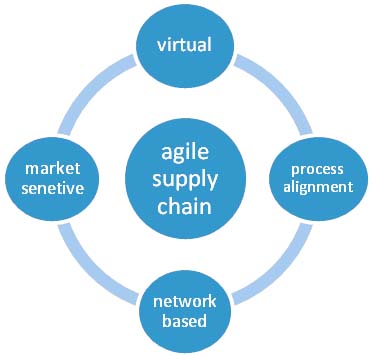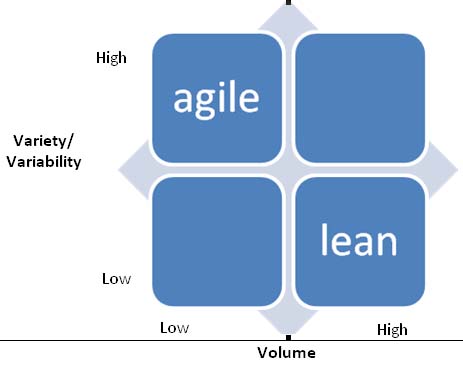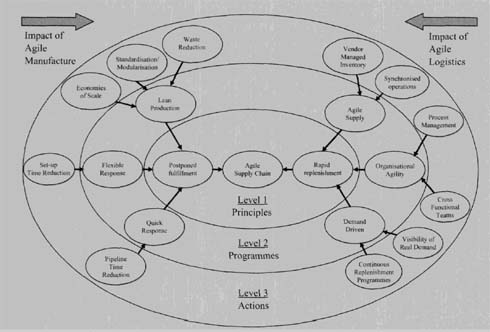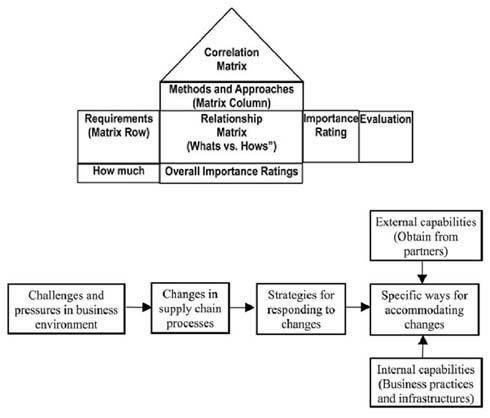Supply Chain Management – The Agile Supply Chain
1.1 Introduction
Seeking a solution to increase the responsiveness of supply chain in a volatile market place, the agile concept has gained a lot of attention recently. In the first section of this report, current market conditions have been reviewed briefly to show the need for more flexibility and responsiveness. In the second section, the meaning of agility and agile supply chain has been illustrated. In the next section, the relationship between lean and agile supply chain has been discussed, and then, in the last part, two approaches towards agile supply chain design has been presented briefly, noting that there are lots of different approaches and methods available.
1.2 New market conditions
In the recent years, the conditions that markets work under have changed significantly. These changes have led to increased uncertainty in the supply chain, and it seems that this uncertainly will continue to increase in the future. The factors that influence the future of supply chain environment can be generally stated as below:
The globalization of supply chain: This while increasing opportunities, rises uncertainties in the supply chain, and increases the risk associated with self imposed actions in any part of a global supply chain.
Convergence of low cost computing and low cost communications: This reduces some of the competition barriers, makes the marketplace more competitive, and it provides the opportunity to overcome some of the uncertainties and demand fluctuations. However at the same time, the consumer demand for variety and higher quality with reasonable cost also increases.
Increase in capability to extend product variety: This fuels the competition, and raises consumer demand simultaneously.
Reduction in technology and product life cycles while remaining cost competitive: This puts the pressure on companies to accelerate the innovation rate or adaptation to innovations, and makes the competition even harder. This also highlights the importance of supply chain speed and responsiveness. (Cai-feng, 2009)
All these factors together will drive the consumers to demand higher value and more variety. Therefore, the demand forecast will be more difficult, while the competition among supply chains gets more intense. As a result, the marketplace will be more turbulent and volatile.
Under these conditions the kind of supply chain approach that has been used so far by companies may not be viable in the future. There is an increasing need for a structure or concept that can combine the speed in service delivery with fluctuated and unpredictable demand, while keeping the cost down.
While the concept of “leanness” has already been applied for a while in supply chains in order to reduce cost and eliminate waste, it has been suggested that companies can survive under these new conditions through “Agility” in their supply chains by creating and increasing the responsiveness to market place turbulences. (Christopher, 2000).
1.3 What dose agility mean in supply chain management
“Agility is a business-wide capability that embraces organizational structures, information systems, logistics processes, and, in particular, mindsets. A key characteristic of an agile organization is flexibility” (Christopher, 2000)
Successful companies have responded to the increasing unexpected changes in demand and supply, by embedding agility into their supply chains. Although many companies are still trying to cope with these rapid fluctuations in demand and supply by playing speed against cost, the agile ones respond quickly while remaining cost efficient. (Lee, The triple-A supply chain, 2004)
A good example of the importance of responsiveness in supply chain and the risks that companies take by not applying it can be seen in the case concerning Compaq. In the 1990s, whenever Intel unveiled new microprocessors, Compaq took more time than its competitors to launch the next generation of PCs. This was because of a long design cycle. As a result, the consumer awareness of product or brand was lost, because it could never count early adopters, who create the buzz around high-tech products, among its consumers. Worse, it was unable to compete on price. Because its products stayed in the pipeline for a long time, the company had a large inventory of raw materials. That meant Compaq did not gain much benefit when component prices reduced, and it could not cut PC prices as much as its competitors were able to. (Lee, The triple-A supply chain, 2004)
1.3.1 The agile supply chain characteristics
As Martin Christopher (2000) explains, the agile supply chain has four major dimensions.

Figure 1: Agile supply chain dimensions adopted from (Christopher, 2000
Market sensitive
Being market sensitive means that the company should be able to read and understand the demand in the market as well as being able to respond to it. Many organisations use forecasting to respond to the market demand. This happens because of the lack of direct information from the consumers and on the time of consumption. Therefore, they have to forecast the demand based on the past information, and provide the products for inventory on those bases. On the other hand, market sensitive companies have access to the point of sale information and respond to the actual feed forward from the consumers, and not from the forecast. This means that an agile company should be demand driven rather than forecast driven.
Virtual supply chain
The traditional logistic systems are seeking to identify the right quantity and the right place to store them through the supply chain. This is an inventory-based approach. On the other hand, a virtual supply chain is information-based. By using information technology applications, such as electronic data interchange (EDI), all parties through the supply chain have access to real and same demand information, and the data will not be distorted by being transferred from one stop to another, through the supply chain. Therefore, in an agile supply chain, it is the information that flows, rather than the products themselves.
Process ingeneration
Having access to the same information cannot be fully achieved without an integrated process and relationship between suppliers and buyers. As more companies outsource every functions, except their core competencies, these kind of integration and trust-based relationships become more crucial. The suppliers and buyers through the supply chain manage the critical functions, such as new product development, through collaboration. This transparency of information even in the accounting area, gives the supply chain the ability to respond quickly to fluctuations in demand, and survive in the turbulent market.
Network
It can be argued that today the competition is no longer among organisations, but between the supply chains instead. It can be called “network competition”, where the success can be achieved by empowering all the parties in the supply chain, and applying better relationship management, structure and co-ordination. By seeing the whole supply chain as one entity, it can become more agile in responding to the customer, and also it can influence and reduce the total cost of supply chain.
1.4 Agility and leanness
It can also be helpful to examine the lean concept and its relationship with agility, as these concepts are sometimes confused with each other. The agile perspective is more concerned with the responsiveness of the supply chain, and aims to reduce the service delivery time, whereas lean is more about eliminating waste and reducing cost.
These two concepts are more complementary rather than being against each other. Depending on the type of products or services that a supply chain provides, one of them can be more suitable to a particular situation. The matrix below shows the dimensions by which a more appropriate supply chain model can be identified.

Figure 2: Lean & Agile supply chain (Lu, 2010)
It has been suggested that a hybrid approach, combining lean and agile, can be the most suitable to fit the different needs of one company or one supply chain. The term “leagile” was used to refer to this hybrid approach for the first time by (J. Ben Naylor, 1999). In that article, it is argued that these two concepts should not be seen in isolation, and also that they can be used together in one supply chain, for which they give a case study example. They define the lean and agile perspectives as:
“Agility means using market knowledge and a virtual corporation to exploit profitable opportunities in a volatile market place. Leanness means developing a value stream to eliminate all waste, including time, and to ensure a level schedule.” (J. Ben Naylor, 1999)
Based on that, then M. Christopher (2001) explains three approaches by which these two concepts can be used to together. (Martin Christopher D. T., 2001)
Pareto curve approach
As 80 per cent of the total volume manufactured by companies usually comes from 20 per cent of the product range, and they are the kind of products that enjoy a more stable demand, they can be made to stock. Therefore, lean approach is useful in managing the supply chain for these products.
On the other hand, the 80 per cent of the products, which are responsible for the 20 percent of sales, suffer fluctuation in demand, and should be made to order. Therefore, the agile supply chain is more suitable for them.
The de-coupling point approach
The idea here is to hold some inventory of generic or modular products, and postpone the final assembly until the more accurate demand information is available. Therefore until that point in the supply chain, the lean approach can be useful, because the products can be made to stock, and from that point onwards, the agile approach should be used to increase the responsiveness to the real demand.
Separation of base and surge demand
Looking at supply chain from this point of view, a base demand can be forecasted and products can be produced (provided) using lean procedures to reduce the cost and achieve economies of scale. The surge demand however is that part of demand which cannot be forecasted, for example, the peak time. The strategy to meet this part of demand should be more flexible, and it will probably have a higher cost. This approach is used heavily in the fashion industry where the more stable demands can be sourced from the cheaper production sites, in low cost countries, and the surge part of the demand can be sourced from the closer suppliers locally to achieve the required flexibility.
Each of these three lean/agile strategies can be used in supply chain management according to any particular situation and they are complementary to each other.
One example of these hybrid approaches can be seen in the Sport-Obermeyer case. (M.L.Fisher, 1994) Even though this case was presented before the introduction of leagile supply chain, it can be seen that the combination of these two approaches proved to be useful. Sport-Obermeyer was a fashion skiwer manufacturer in the USA. Until the mid 1990’s they had worked successfully for about 30 years under the traditional supply chain method, using many lean enablers. At that time, the company faced many difficulties due to the inaccuracy of forecasts. It resulted in the company being out of stock for some items, and having too much inventories for other styles, which it could not sell. A research was conducted at that time to reduce the error in forecast demand. The research team suggested some remedies, which proved to be advantageous. One of them was to provide distinction between the products that can be forecasted for, and those which could not. By doing that, company could allocate its base capacity to produce the products with stable demand, and save the capacity for products with more fluctuations in demand until receiving the real demand data (i.e. early season demand). This approach is what Christopher introduces as Pareto curve strategy.
One other thing that the company did was collaborate with its suppliers to change the design of the products in order to use more similar initial components in terms of both colour and material. For example, instead of using zippers with the same colour as the garment, it was to use black zippers which not only was a fashion element, but also it would be a generic component that can be manufactured and stored in advance. This approach is similar to what Christopher presents as the de-coupling point approach.
1.5 How does a supply chain can become agile
Many studies have been done on what agility is, and the importance of a supply chain being agile. However relatively fewer researches have focused on the design of an agile supply chain, and its implementation.
Christopher suggests a three level “agile supply chain” design, which is shown in figure bellow.

Figure 3: Three level agile supply chain (Martin Christopher D. T., 2001)
The first and core level consists of three elements, rapid replenishment, agile supply chain and postponed fulfilment, which he calls principle level.
Level two (programmes level) are the programmes that should be implemented in order to achieve the principles such as organisational agility, lean production and so forth.
Level three (actions level) presents the specific actions that should be undertaken in order to support the programmes.
This model gives a broad and general view of the agile enterprise, but it does not address the actual methods of implementation to design an agile supply chain.
Another model in order to help the design of agile supply chain has been introduced by (Manisra Baramichai, 2007). This is a more practical model, which is concerned with the actual design process. The model is shown below.

Figure 4: Agile supply chain transformation matrix (Manisra Baramichai, 2007)
The conceptual base of the model is on quality Function Deployment (QFD) and analytic hierarchy process (AHP). The writers argue that the most important aspect of an agile supply chain is the environment in which the parties work, and the success of the supply chain is depended on identifying what external factors are and what the customer demands. Therefore, they suggest using QFD to identify the supply chain characteristics based on the external demand. QFD usually is used to translate the customer requirements into product specification, in the design phase. In this article, it is used to translate the external demand and factors into supply chain characteristics. As there are enormous numbers of factors involved, the article suggests the use of AHP to prioritise the influential factors, and select the most important ones.
Dr Lee has also suggested some methods in order to achieve agility in supply chain in his triple-a model. His emphasis is on developing a collaborative relationship with suppliers and also with the logistics partners. He also suggests having some inventories of key items similar to what Christopher suggest as having inventory of generic components.
One element that he mentions, and seems not to be highlighted by many others, is risk management and placing contingencies. As mentioned in the first section, the risks that supply chains are facing now are much higher and more varied in nature. This can threaten the responsiveness of the supply chain by slowing the flow of information and goods. This is an area that should be noted carefully both when designing a supply chain and also in supply chain management.
Methods to achieve agility objectives in supply chain (Lee, The triple-A supply chain, 2004)
- Promote flow of information with suppliers and customers.
- Develop collaborative relationships with suppliers.
- Design for postponement.
- Build inventory buffers by maintaining a stockpile of inexpensive but key components.
- Have a dependable logistics system or partner.
- Draw up contingency plans and develop crisis management teams.
1.6 Conclusion
The current market place situation can be called a time-based competition era, where supply chains compete with each other to provide goods and services in a shorter time, while remaining cost effective. Agility is a proper answer to the new market conditions. It should also be noted that different supply chains provide different products and services with different characteristics. It is vital for the success of any supply chain to distinguish between products and adopt suitable approaches. Lean and agile concepts can be successfully merged, in order to respond to different needs and conditions of supply chains.
1.7 References
Cai-feng, L. (2009). Agile Supply Chain: competing in volatile markets. Management Science and Engineering , 3 (2), 61-64.
Christopher, M. (2000). The Agile Supply Chain, Competing in Volatile Markets. Industrial Marketing Management , 29, 37-44.
J. Ben Naylor, M. M. (1999). Leagility: Integrating the lean and agile manufacturing paradigms in the total supply chain. International Journal of Production Economics , 62 (1-2), 107-118.
Lee, H. L. (2004). The triple-A supply chain. Harvard business review , 102-112.
Lu, D. D. (2010). Supply chain management module’s notes. coventry: warwick manufacturing group.
Manisra Baramichai, E. W. (2007). Agile supply chain transformation matrix:an integrated tool for creating an agile enterprise. international journal of supply chain management , 12 (5), 334-348.
Martin Christopher, D. T. (2001). An integrated model for the design of an agile supply chains. International Journal of Physical Distribution & Logistics Management , 31 (4), 235-246.